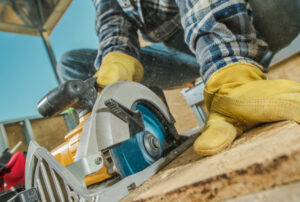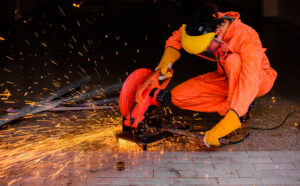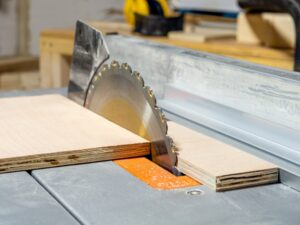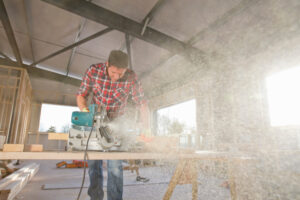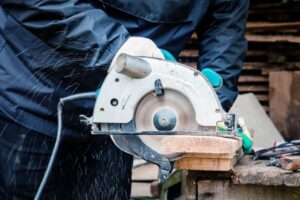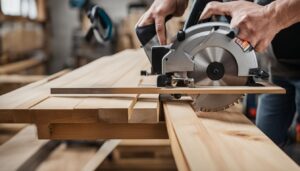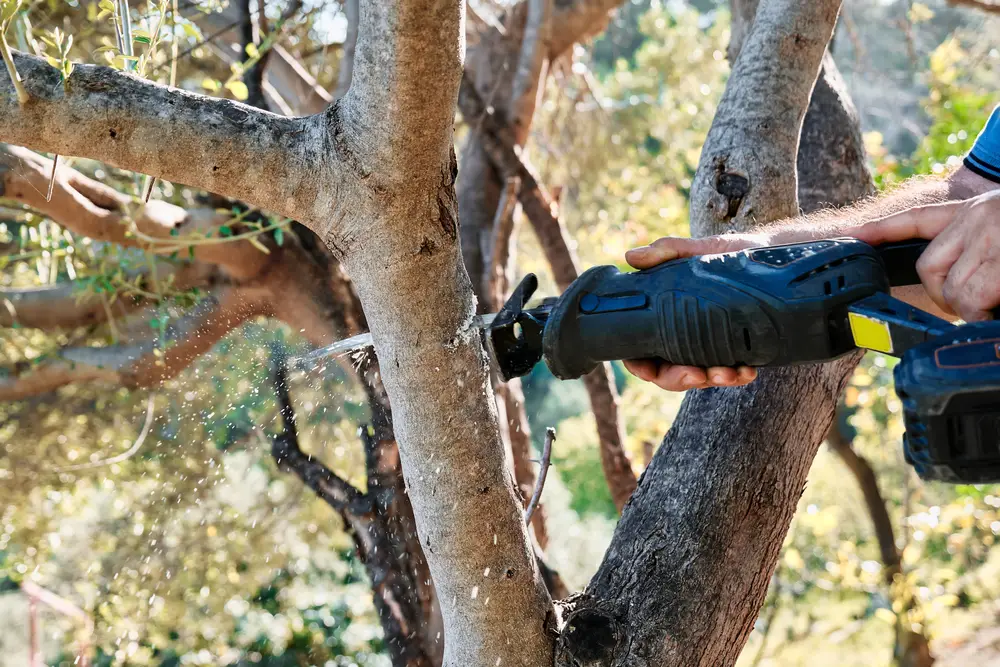
Reciprocating saws are versatile tools that can cut through various materials. They are designed for use in cramped and restricted spaces, making them invaluable for certain applications. However, it is important to follow safety guidelines to ensure safe operation. Some key tips include proper training and instruction, wearing appropriate protective equipment, and maintaining the saw in good condition.
Key Takeaways
- Proper training and instruction are essential for safe operation of a reciprocating saw.
- Wearing appropriate protective equipment, such as eye and hearing protection, is crucial.
- Inspect the saw and familiarise yourself with its operation before use.
- Follow safety guidelines, including avoiding loose clothing and ensuring the saw’s switch functions properly.
- Maintain the saw’s blade and equipment, and avoid over-pressure on cuts.
- If any operational problems are noted, remove the saw from service and get it repaired immediately.
- Disconnect the power source when repairing tools or changing blades, and avoid using power tools in wet environments.
Familiarise Yourself with Your Reciprocating Saw
Before using a reciprocating saw, it is crucial to become familiar with the tool. This will not only ensure safe operation but also enhance the overall efficiency of your work. I recommend following these steps to familiarise yourself with your reciprocating saw:
- Read the Operator’s Manual: Take the time to thoroughly read and understand the operator’s manual provided by the manufacturer. This manual will provide valuable information on the tool’s specifications, safety guidelines, and proper maintenance.
- Visual and Operational Inspection: Before using the saw, perform a visual inspection to check for any visible damages or defects. Inspect the power cord, handle, and blade for any signs of wear or damage. Additionally, conduct an operational inspection by testing the saw’s functions such as the trigger switch, blade release mechanism, and adjustable shoe.
- Test-Run the Saw: To get a feel for the saw’s performance, conduct a test run in a safe and controlled environment. Practice making several cuts on various materials to familiarise yourself with the saw’s cutting power, speed, and control. This will allow you to adjust your technique and gain confidence in handling the saw.
| Benefits of Familiarising Yourself with Your Reciprocating Saw |
|---|
| Improved Safety |
| Enhanced Efficiency |
| Increased Confidence |
By taking the time to read the manual, inspect the saw, and test-run it, you can ensure the safe and effective operation of your reciprocating saw.
Follow Safety Guidelines for Reciprocating Saw Use
When operating a reciprocating saw, it is crucial to prioritise safety to prevent accidents and injuries. By following these safety guidelines, you can ensure a safe and productive work environment:
Wear Proper Eye and Hearing Protection
Protecting your eyes and ears is essential when using a reciprocating saw. Wear safety glasses or goggles to shield your eyes from flying debris, and use earplugs or earmuffs to reduce the risk of hearing damage caused by the tool’s loud noise.
Use Gloves and a Dust Mask if Necessary
Depending on the materials being cut, it may be necessary to wear gloves to protect your hands from sharp edges or harmful substances. Additionally, if you are working with materials that produce a significant amount of dust or particles, wearing a dust mask can help prevent respiratory problems.
Avoid Loose Clothing or Untied Long Hair
Loose clothing or untied long hair can pose hazards when using a reciprocating saw. It is important to wear appropriate work attire and ensure that your hair is securely tied back to avoid entanglement with the tool.
Inspect the Workpiece and Saw
Before using the saw, inspect the workpiece for any potential hazards such as nails, screws, or other objects that could damage the tool or cause kickback. Additionally, check the saw’s spring-loaded on/off trigger switch to ensure it functions properly.
Maintain a Clear Work Area
Keep the work area free of any trip hazards or clutter that could impede your movement or cause accidents. Ensure adequate lighting and sufficient space to manoeuvre the saw safely.
Operate Only Well-Maintained Equipment
Regularly inspect and maintain your reciprocating saw to ensure it is in good working condition. Check the blade for cleanliness, straightness, sharpness, and tightness of the set screw. If any operational problems are identified, remove the saw from service and have it repaired immediately.
| Safety Guideline | Description |
|---|---|
| Wear Proper Eye and Hearing Protection | Protect your eyes with safety glasses or goggles and use earplugs or earmuffs to reduce noise exposure. |
| Use Gloves and a Dust Mask if Necessary | Wear gloves to protect your hands and a dust mask to prevent inhalation of harmful particles. |
| Avoid Loose Clothing or Untied Long Hair | Wear appropriate work attire and tie back long hair to prevent entanglement with the tool. |
| Inspect the Workpiece and Saw | Check the workpiece for hazards and ensure the saw’s on/off trigger switch functions properly. |
| Maintain a Clear Work Area | Keep the work area free of clutter, trip hazards, and ensure adequate lighting. |
| Operate Only Well-Maintained Equipment | Regularly inspect and maintain your saw, checking the blade and addressing any operational issues. |
Maintain Safety During Reciprocating Saw Operation
When it comes to operating a reciprocating saw, prioritizing safety is paramount. By following proper maintenance practices, you can ensure your tool’s safe and effective use. Here are some key tips to maintain safety during reciprocating saw operation:
Regular Blade Inspection and Maintenance
Inspecting and maintaining the blade of your reciprocating saw is crucial for safe operation. Check the blade regularly for cleanliness, as debris buildup can affect its performance. Ensure that the blade is straight, sharp, and securely tightened with the set screw. A loose or damaged blade can result in accidents and compromised cutting efficiency.
Adhere to the Recommended Blade Speeds
Blade speeds are typically specified by the manufacturer for different materials and cutting applications. It is important to follow these recommendations to prevent overheating and potential kickbacks. Operating the saw at excessively high speeds can increase the risk of accidents while using low speeds can result in inefficient cuts and excessive wear on the blade.
Use Proper Cutting Techniques
When operating a reciprocating saw, it’s essential to use proper cutting techniques to maintain safety. Avoid applying excessive downward pressure on the saw, as this can cause the blade to bind or kickback. Instead, let the reciprocating action of the saw do the work, applying gentle pressure and allowing the blade to cut through the material. This technique not only ensures safer operation but also prolongs the life of the blade.
| Maintenance Tip | Description |
|---|---|
| Regular Cleaning | Remove debris and buildup from the saw after each use to maintain optimal performance and prevent clogging. |
| Lubrication | Apply a few drops of lubricating oil to the blade and moving parts to reduce friction and enhance the saw’s lifespan. |
| Proper Storage | Store your reciprocating saw in a clean and dry area to prevent moisture damage and ensure it is ready for safe operation. |
By following these maintenance tips and techniques, you can enhance the safety and longevity of your reciprocating saw. Remember always to prioritise your safety and the safety of those around you when operating power tools.
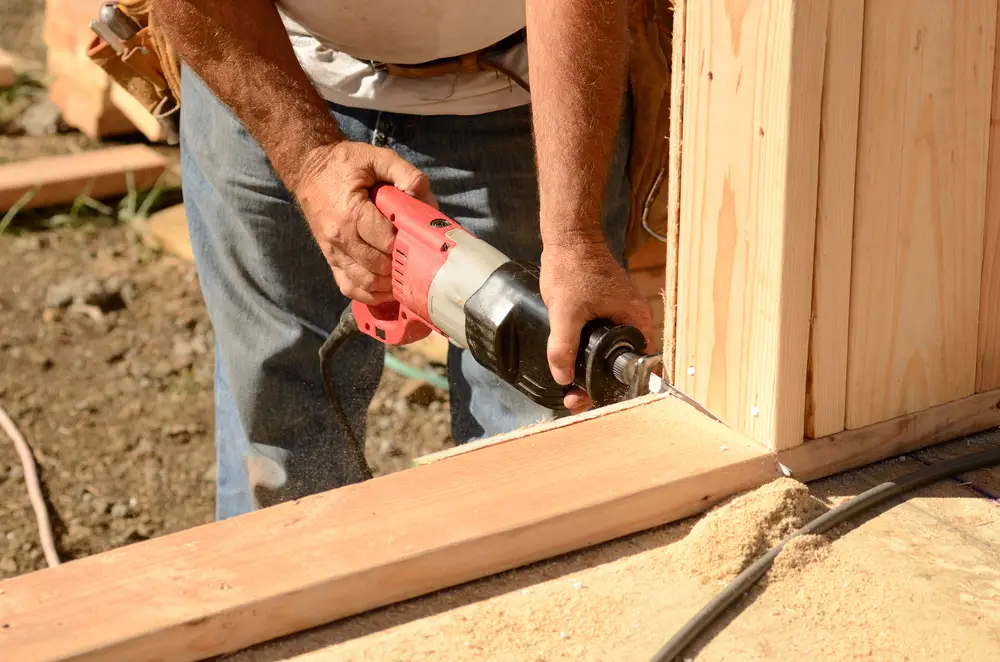
Conclusion
Remember to always prioritise the use of personal protective equipment, maintain proper tool maintenance, and adhere to recommended safety practices. Safe use will allow you to unlock the full potential of your reciprocating saw while minimising the risk of accidents or injuries.
In conclusion, operating a reciprocating saw requires careful attention to safety. By familiarising yourself with the tool, following safety guidelines, and properly maintaining the saw, you can ensure a safe working environment. Reciprocating saws are versatile and powerful tools, but their potential can only be fully realised when used responsibly. So, keep these tips in mind and enjoy the safe and efficient operation of your reciprocating saw.
FAQ
What materials can a reciprocating saw cut through?
A reciprocating saw is versatile and can cut through a variety of materials, including wood, metal, plastic, and even masonry.
Why is it important to wear eye and hearing protection when using a reciprocating saw?
Wearing proper eye and hearing protection is crucial because a reciprocating saw generates noise and can produce flying debris during operation. Protecting your eyes and ears prevents potential injuries.
Are there any specific safety precautions for using a reciprocating saw in cramped spaces?
Yes, when using a reciprocating saw in cramped spaces, ensure that there is enough room to maneuver the tool safely. Be aware of any obstacles or hazards that may restrict your ability to operate the saw safely.
How often should I check the blade and set screw on my reciprocating saw?
It is important to regularly inspect the blade for cleanliness, straightness, sharpness, and tightness of the set screw. Before each use, check the blade and set screw for any signs of damage or looseness.
Can I use a reciprocating saw in wet environments?
No, it is not recommended to use power tools, including reciprocating saws, in wet environments. Water can pose a significant risk of electrical shock and damage to the tool.
- Drill Battery Maintenance: Essential Tips for Cordless Drill Battery Care - February 5, 2024
- Troubleshooting Drill Issues - February 5, 2024
- Quick Drilling Techniques - February 2, 2024


